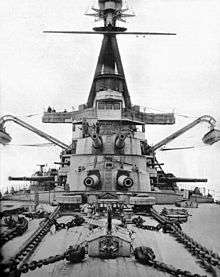Superfiring

The idea of superfiring armament is to locate two (or more) turrets in a line, one behind the other, but with the second turret located above ("super") the one in front so that the second turret could fire over the first. This configuration meant that both forward or aft turrets could fire at any target within their sector, even when the target was in the same vertical plane as the turrets.
History
The history of large surface warships follow generic labels as battleships, and a further distinction between pre-dreadnoughts and dreadnoughts. The era of technical evolution occurred roughly from 1900 to 1945. Part of the technical evolution was driven by the need to compress as much large-gun firepower into the smallest space possible. In early designs, the large-caliber turrets were all located on the same plane firing to one side or the other. In firing ahead or to the rear, usually only the forward-most or rearmost turret could fire, especially at low angles.

An early concern was that the pressure and shock from the higher turret would damage the lower one when firing over the top. United States Navy tests using the monitor USS Florida (BM-9) as the testbed, proved that superfiring was safe. The result was the design for the first South Carolina-class battleship.
The first ship with superfiring artillery (not of the same caliber, though), was the French battleship Henri IV, launched in 1899.[1]
Superfiring was not limited to only two turrets, for example the Atlanta-class of light cruiser, which were developed and built for service in World War II. These ships utilized a triple-overlap system both forward and astern, their armament of dual-mount 5"/38 cal dual-purpose main armament having a nearly unobstructed arc of fire.
Foototes
- ↑ Reprinted from Brassey's Naval Annual, 1912.
References
Notes
- ↑ Roger Chesneau, Eugène Kolesnik (ed.): Conway's All the World's Fighting Ships, 1860-1905, Conway Maritime Press, London, 1979, ISBN 0-85177-133-5, p.295